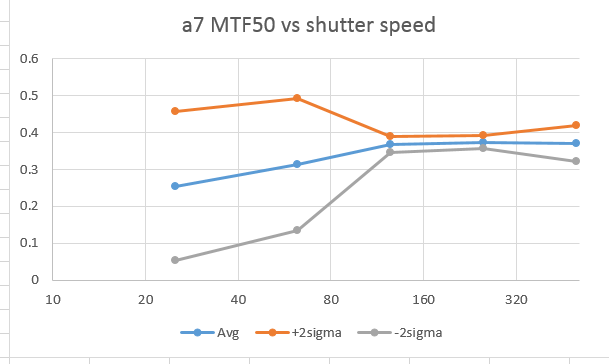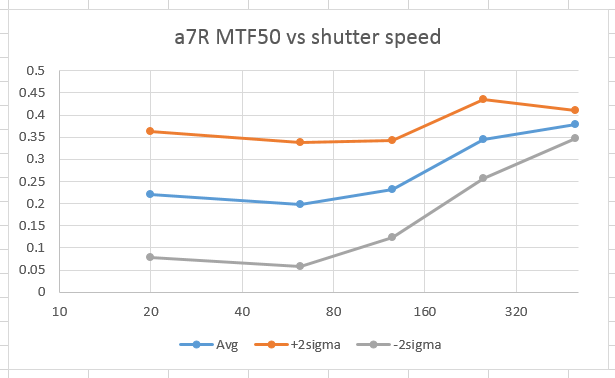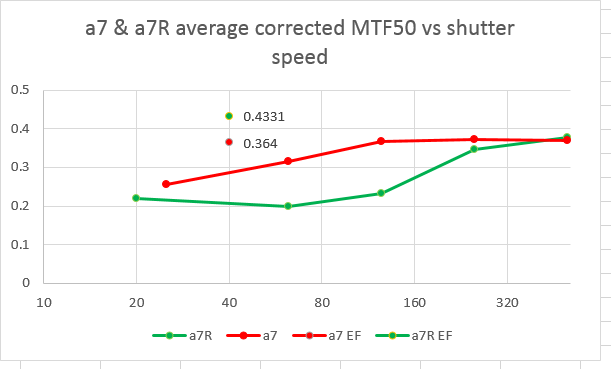The cameras: the Sony a7 and a7R. The lens: the Sony/Zeiss (aka Zony) 55mm f/1.8 Sonnar FE. The lighting: a single Fotodiox LED-200WA-56 daylight balanced variable-power flood. ISO set to 400, f-stop set to 5.6, focusing in single shot AF mode with the small focus area setting, drive set to single, the exposure mode set to A. The protocol: light on full, adjust exposure compensation for 1/500 second, make 12 exposures with new focusing for each, light down a stop, make 12 exposures… until you get to 1/30 of a second or so.
Develop in Lightroom 5.3 with settings as in the previous post. Crop, export as TIFFs, analyze for horizontal edge MTF50 in Imatest. Export the results to Excel, crunch the stats, and graph.
Here are the results for the a7, with average, average plus two standard deviations, and average minus two standard deviations plotted. Don’t put too much emphasis on the standard deviation derived lines. If the stats were Gaussian, and I don’t know that it is, 96% of the outcomes would lie between those lines.
The statistical spread on the results fro 1/125 through 1/500 is surprisingly tight. It looks like the new digital-era rule of using a shutter speed where the denominator is at least twice the FF-equivalent focal length works for the a7, at least in my hands.
Here are the results for the a7R, with the MTF50 numbers corrected for the smaller pixel pitch of the camera, so that the unit of the denominator of MTF50 for both cameras is the pixel pitch of the a7’s sensor:
We can see variability at 1/250, but no material loss in average value.Still, because of the variability, I’d suggest 1/500 as the minimum a7R shutter speed for handheld work where sharpness is important. I almost said “where sharpness is critical” but you’d almost certainly have the camera on a tripod if that were the case.
And here are just the averages for both cameras plotted on the same graph, together with the numbers from the electronic flash lit images from the previous post. The strobe images are arbitrarily plotted at a shutter speed of 1/40:
What’s it all mean? First, if I’m handholding this lens on the a7 and a7R, I’ll get sharper pictures (in the vertical direction, anyway) with the lower-resolution camera in the shutter speed range from 1/60 to 1/125, and probably a little bit on both sides of that range. Second, when using the a7R handheld, the shutter speed range most likely to give me trouble is the same range that is most problematic with this lens when the camera is mounted on a tripod. Third, the a7 handheld at shutter speeds of 1/125 and up can come quite close to its tripod-mounted, strobe-lit performance. That’s pretty remarkable, especially considering that I have difficulty wrapping my big hands around the camera as securely as I do with a big DSLR.



if you can test @ which exposure time hand held (by your subjective hands) A7r might reasonably match those tripod mounted, strobe illuminated (1/5000 t1 duration) results ?
Unfortunately, I don’t have a continuous light bright enough to do that. On second thought, I could do it at a wider aperture, but the results might not be as accurate because the lens resolution will be lower. Hmm…